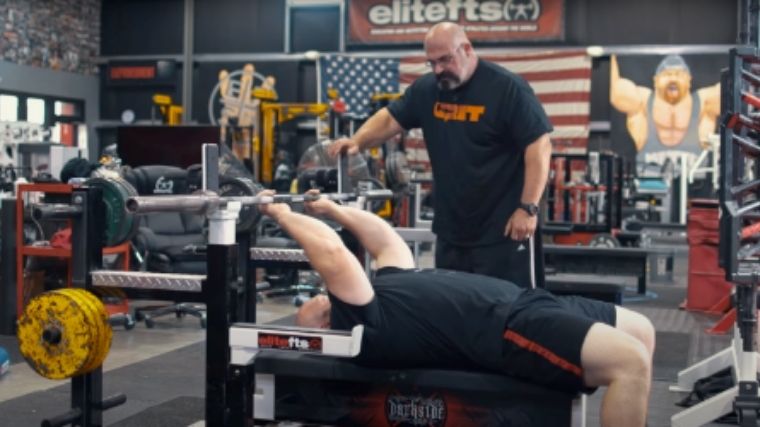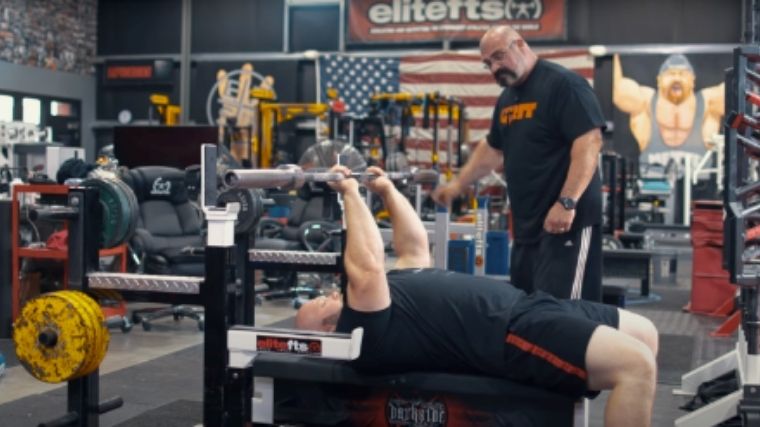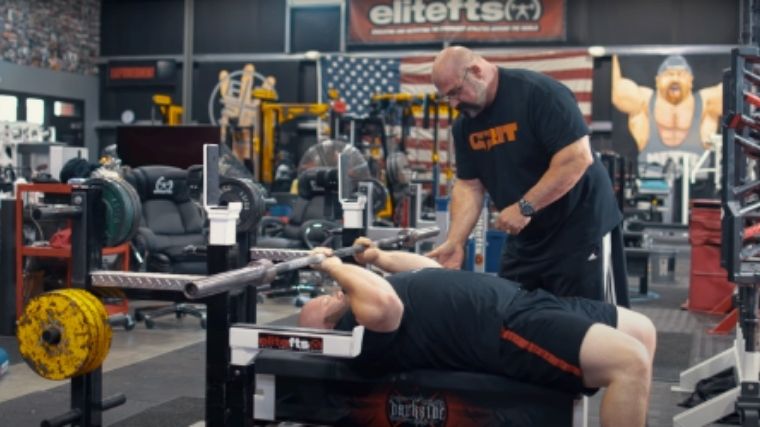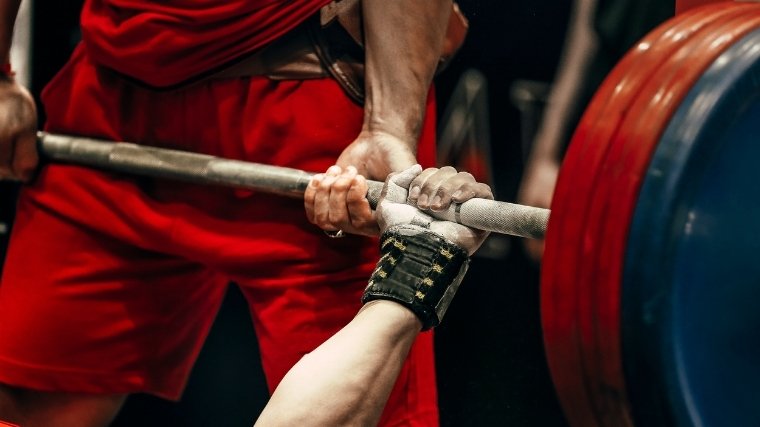Let the JM Press Be Your Key to Bigger and Stronger Triceps
Your triceps — the muscle that sits on the back of your arm and flexes your elbow — are important for building bigger arms and moving more weight on the bench press. And few moves are better at strengthening and growing your triceps than the JM Press — a bench press-skull crusher hybrid that allows you to lift more weight and has direct carryover to horizontal pressing movements.
The move is the brainchild of esteemed powerlifter JM Blakely, and it’s now used by strength athletes as an aid to their bench press training. Below, we’ll walk you through how to do the JM press, the move’s benefits, alternatives and variations.
- How to Do the JM Press
- JM Press Sets and Reps
- Common JM Press Mistakes
- JM Press Variations
- JM Press Alternatives
- Muscles Worked by the JM Press
- Benefits of the JM Press
- Who Should Do the JM Press
- Frequently Asked Questions
How to Do the JM Press
To perform the JM Press, you’ll take the lying position and approximate hand-placement of a traditional close-grip bench press and perform the movement by lowering the bar toward your chin and back up to the starting position. Below, you’ll find a step-by-step process on how to perform this exercise properly.
Step 1 — Get Set

Set up for a close-grip bench press. Lie on a weight bench with your feet set flat on the floor just outside shoulder-width apart, with the barbell positioned above your forehead.
Tip: You do not want to be positioned directly under the barbell, as this will not allow for a full range of motion during the press. Being positioned too close also runs the risk of hitting the bar on the rack when lowering the bar.
Step 2 — Unrack the Weight

Rest the barbell in your hand with a thumbless grip. Ensure that your wrists are in a stable position and are not overly flexed or extended. Unrack the barbell. Establish a starting position above your chin.
Tip: Due to positioning and the novelty of the exercise, you may want to have a spotter to ensure a safe unrack and rerack of the barbell.
Step 3 — Press the Weight

Flex generously at your elbows so that the bar is positioned above your forehead instead of above your chin or chest. Maintain a straight bar path by pulling down with your shoulders. Lower the barbell to just above your forehead. Press back up while keeping your elbows in the same position the entire time.
Tip: Add stability to your elbows by placing tension in your biceps during the eccentric portion. When pressing the bar, think about punching the bar away from you to the starting position.
JM Press Sets and Reps
JM presses are very helpful for making sure your strength and triceps muscle games are on point. You’ll likely turn to this exercise as an arm hypertrophy move, with strength and even endurance as supplemental goals. Try out these sample set and reps schemes to help you figure out how to use the JM press to advance your specific needs.
- For Muscle Growth: Perform two to three sets of eight to 12 reps, approaching failure with each set.
- For Strength: Do three to four sets of six to 10 reps with moderately heavy weight.
- For Endurance: With lighter but still challenging weight, do three to four sets of 15 to 20 reps.
Go moderately heavy when necessary, but make sure the weight you’re using isn’t agitating your shoulders or elbows.
Common JM Press Mistakes
The JM press is relatively easy to execute once you know what you’re doing, but it can have a steep learning curve. It’s a finnicky movement, so make sure you’re not making any of these common lifting mistakes as you’re learning.
Too Much Weight
Since this has a lot of similarities to the bench press, it might be tempting to load on a lot more weight than you would with a regular skull crusher. And while this move does allow you to move more weight, you want to increase it responsibly. Make sure that your form is locked in with your wrists in neutral at all times. If you’re having trouble maintaining the positions required for the JM press, lower the weight until you can build the positional strength you need before progressing.
Too Much Press
As a hybrid between the skull crusher and the close-grip bench press, the JM press requires that your arm angle is quite different than a straightforward up and down. If you load the bar with too much weight, your body will likely try to compensate by pressing the bar entirely instead of also "skull crushing" it up. Lower the weight if this happens. You should also focus on using a thumbless grip and bringing the backs of your forearms parallel instead of perpendicular to the ground.
Too Much Skull Crushing
Conversely, you might err on the side of performing a total skull crusher instead of the hybrid move that that is the JM press. If you find that this is the case, try a mental experiment. Get into a skull crushing position, with the backs of your forearms roughly parallel to the ground. Then, lower the bar as you would with a bench press, keeping your arms in the same position. Press up, also from that position. Little movement cues like this can help prevent you from taking the "press" out of the JM press.
JM Press Variations
There’s more than one way to push your triceps to the limit with the JM press. Here are some variations to try.
JM Press with EZ-Bar
Performing the JM Press with the EZ-bar is a great alternative to the barbell variation for anyone who experiences wrist discomfort. The inward range of the EZ bar allows your wrist to remain more neutral during the lift, which prevents excessive flexion, or backward bending of your wrist.
Because you (most likely) won’t be able to use as much weight on this variation, be sure to perform more reps.
JM Floor Press
This exercise is to the JM press as the floor press is to the bench press. By performing the JM press on the floor, you restrict your range of motion and allow for two things to happen.
First, you can lift more weight for a greater strength-building response. Second, your triceps — which are most active during the top portion of the bench press — will be more engaged overall.
JM Press with Multi-Grip Bar
The multi-grip bar — often referred to as the Swiss bar or football bar — allows for multiple hand grip placements in a semi-pronated position.
The choice of grip on this variation can allow for more individualization compared to a traditional barbell.
JM Press on Smith Machine
Doing the JM press on a Smith machine allows for better technique, as the Smith machine is on a fixed path.
You won’t be able to break the bar path. Since you’ll have to worry less about stability, you might find yourself able to heft more weight.
JM Press Alternatives
Looking to vary up your triceps training without quite commiting to the JM press? Try out these alternatives to blow up your arm size and your bench lockout.
Close-Grip Barbell Bench Press
Bringing your hands closer together on the conventional bench press will place a lot more emphasis on your triceps. Yes, you’ll have to lift a lot less weight than you can when fully deploying your chest muscles, but this version will target your tris for bigger lockout strength.
The close-grip bench press will still train you to press with your triceps as the biggest mover, but you won’t need to master a different movement pattern to get there.
Floor Press
The floor press limits your range of motion from the regular bench press or close-grip bench press. Since you’ll be lying on the floor, you don’t have the added clearance granted by the bench of bringing your elbows down a bit beneath your body.
Because of this smaller range, the floor press helps you perform heavy pressing motions while potentially sparing your shoulders some grief. This is what makes it a suitable alternative to the JM press.
Dumbbell Skull Crusher
This move follows a similar movement pathway as the JM press. But this time, you’ll be performing the lift with dumbbells. Using dumbbells frees up your shoulders even more for the most customized line of movement for your shoulders.
With the skull crusher, you’ll be lifting less weight because it involves less of a "press" than the JM press. But less weight doesn’t mean an inferior lift — it just means you can err on the side of emphasizing endurance a little bit more. That’s bound to come in handy when your triceps are fatigued at the end of a harder bench press set.
Muscles Worked by the JM Press
The JM Press is an upper-body pressing movement that helps place more tension on your triceps compared to a more traditional bench press. The narrow hand placement allows for increased elbow flexion, leading to increased triceps engagement. All of this happens while placing minimal strain on your wrists and shoulders.
Triceps
Your triceps act as a main mover in the JM Press. The exercise’s unique movement pattern helps place more load on your triceps while minimizing tension placed on surrounding muscle tissue, such as your chest and shoulders.
Deltoids (Shoulders)
The deltoids help stabilize your shoulder joints during this exercise. Although the main focus of the JM Press is on elbow flexion-extension, your shoulders are abducted (away from the midline) around 30-45 degrees.
Benefits of the JM Press
The JM Press offers an array of benefits for all levels of athlete or fitness enthusiast. Below you will find three of the top benefits.
More Triceps Strength and Size
The JM Press is an exercise that can place high amounts of tension on your triceps and can help build muscle and strength. While it is a bench press variation, you are drastically flexing your elbows, which is a movement controlled by your triceps.
Improved Bench Press Lockout
When it comes to posting a big bench press, a limiting factor can be the strength of your lockout. Your triceps are key for locking out the bench, as they’re the muscles that fully extend your arms. So, by strengthening your triceps, you’re improving the top half of your bench press lockout. Outside of the realm of powerlifting and strength sports, the ability to have significant elbow flexion strength and power extends to things such as gymnastics and other athletic activities.
Limits Strain on Your Shoulders
Many barbell-based compound pressing movements have the potential to place high amounts of strain on your shoulders. The JM Press can be used to place more tension on your triceps while minimizing the potential for strain around your shoulders.

Powerlifters, strongman athletes, bodybuilders, and general fitness enthusiasts may find that the JM press allows them to develop their pressing strength and lockout performance while limiting the strain and long-term wear and tear on the shoulder joint.
Who Should Do the JM Press
The JM press can benefit a broad range of athletes. Here are some of the top types of lifters on that list.
Strength and Power Athletes
Improving the strength and lockout performance of the triceps is key to the success of many strength and power athletes. These sports require movements like the bench press, log press, clean & jerk, and many other vertical and horizontal movements that require significant amounts of triceps strength.
- Powerlifters and Strongman Athletes: The benchpress, log press, and many other vertical and horizontal pressing variations demand significant triceps strength. Utilizing the JM Press among other compound and isolation exercises will help build size and strength to the arms while having direct carryover to strength sports.
- Olympic Weightlifters: The JM Press is an excellent accessory exercise when it comes to triceps strength, joint health and tendon strength, and overall lockout performance necessary for movements such as the clean & jerk. This variation can specifically help those athletes who lack upper body strength while minimizing the risk of irritating your shoulders.
CrossFit Athletes
CrossFit athletes and those training for sport can use the JM Press within their programming to help increase upper body strength and muscle mass, especially in their triceps.
Strong triceps will be important for maximizing performance in barbell-pressing variations (overhead press, bench press, overhead squats, and Olympic variations) and bodyweight variations (handstand and ring variations, wall balls, and burpees).
Bodybuilding and General Athletes
Training specifically for physique goals — whether for competitive bodybuilders or general fitness enthusiasts — can be beneficial for building size, strength, and improving overall body composition. The JM Press can be a great accessory for building overall size and strength of your triceps, helping you grow bigger arms and increase strength in pressing variations (bench press and overhead press).
Press it Up
Are you stalling at your bench press lockout? Try the JM press. Want to turn that new t-shirt into a muscle tank with the sheer power of your arm size? Ditto: the JM press. If your goals in the gym involve anything related to saving your shoulders some strain while building your bench press (and your arms), the JM press is a great bet. Bank on it for triceps strength and size, all the while giving your shoulders a bit of a break.
FAQs
Ready to build massive triceps but have some questions about the JM press before you go? Here are the most commonly-asked questions about this move — and all the answers you need.
When should I do the JM Press?
The JM press can be added to your program to help place more tension on your triceps while minimizing strain on your shoulders. Use it as an accessory movement after your main lifts of the day.
Is the JM Press better for my shoulders?
When compared to a more conventional bench press, most likely. Your arms are less abducted, and there is little to no movement at the shoulder joint. The JM press’s main motion comes from elbow flexion-extension, which is generally easier on your shoulders. Of course, if you have a pre-existing shoulder injury, you should consult with a doctor before training.
Should I warm-up for the JM press?
The JM Press is an exercise that places significant amounts of tension on your triceps, and therefore your elbow joints. Warming up will help you protect your elbows and ensure you do not strain your triceps. Start with a low and manageable load and ascend the weight-used through your sets.
Can beginners use the JM Press?
Yes. But understand that this is a more advanced exercise. If you are a beginner, ensure that you start with no load on the barbell — or use one of the variations — and you focus on proper technique. Starting slow will ensure your safety while working on your skill acquisition and building up strength in your triceps.
{"@context":"https://schema.org","@type":"FAQPage","mainEntity":[{"@type":"Question","name":"When should I do the JM Press?","acceptedAnswer":{"@type":"Answer","text":"
The JM press can be added to your program to help place more tension on your triceps while minimizing strain on your shoulders. Use it as an accessory movement after your main lifts of the day.
"}},{"@type":"Question","name":"Is the JM Press better for my shoulders?","acceptedAnswer":{"@type":"Answer","text":"
When compared to a more conventional bench press, most likely. Your arms are less abducted, and there is little to no movement at the shoulder joint. The JM pressu2019s main motion comes from elbow flexion-extension, which is generally easier on your shoulders. Of course, if you have a pre-existing shoulder injury, you should consult with a doctor before training.u00a0
"}},{"@type":"Question","name":"Should I warm-up for the JM press?","acceptedAnswer":{"@type":"Answer","text":"
The JM Press is an exercise that places significant amounts of tension on your triceps, and therefore your elbow joints. Warming up will help you protect your elbows and ensure you do not strain your triceps. Start with a low and manageable load and ascend the weight-used through your sets.u00a0
"}},{"@type":"Question","name":"Can beginners use the JM Press?","acceptedAnswer":{"@type":"Answer","text":"
Yes. But understand that this is a more advanced exercise. If you are a beginner, ensure that you start with no load on the barbell u2014 or use one of the variations u2014 and you focus on proper technique. Starting slow will ensure your safety while working on your skill acquisition and building up strength in your triceps.
"}}]}
Featured image: elitefts / YouTube
Deja una respuesta

►Te puede interesar...